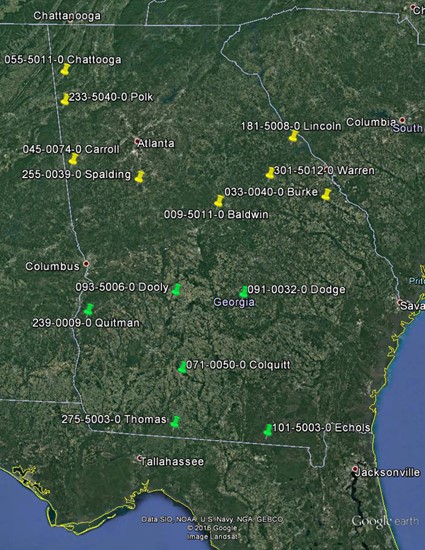
photo credit: GDOT
Georgia DOT's design-build (D-B) bridge bundle projects included replacing 14 off-system bridges in fiscal year (FY) 2017 by using State funds in two D-B contracts: one bundle of six and one bundle of eight bridges.
| Name of Agency | Georgia Department of Transportation (GDOT) |
|---|---|
| Location | Statewide |
| Project Delivery Method | Design-Build (D-B) |
| Procurement Method | Low Bid |
| Total Project Cost |
Future funding is $30 million per year |
| Funding Source | 100% State-Funded. No local match |
| Construction Schedule | GDOT gives 1,095 days per bridge bundle with a time duration for a road closure assigned for each bridge. |
| Project Description | Georgia's Transportation Funding Act of 2015 resulted in an additional $757 million in 2016 and an estimated $824 million in 2017 for GDOT. With that, the GDOT bridge program increased from $155 million in 2015 to approximately $279 million in 2016, $301 million in 2017, and $369 million in 2018. In an effort to ramp up bridge replacement and repair of locally owned bridges, GDOT began a bridge bundling program. The goal of the program is efficiency and speed. The target of the program is county-owned bridges. GDOT meets with the counties when choosing bridges for the program for endorsements and concurrence. GDOT decided to use the D-B project delivery method coupled with low-bid procurement for the program. The D-B request for proposals (RFPs) is very prescriptive and includes 50 percent design plans in the package. In an effort to save time during the procurement process, GDOT does not include an opportunity for alternative technical concepts. Instead, the bundle projects include an industry forum with a chance for participating teams to conduct one-on-one meetings with GDOT to propose innovative ideas. |
| Project Website | None |
| Program Goals | Georgia has more than 1,300 county bridges in poor condition statewide. GDOT's program goal was to deliver projects quickly and efficiently in order to rapidly reduce the number of locally owned bridges in poor condition. |
|---|---|
| Bridge Selection Criteria | The screening process is vital to project success. Bridges that could hold up the contract are eliminated.
|
| Delivery and Procurement Method | D-B, Low Bid (Contractors must be prequalified) |
| Funding Sources, Financing Strategy | 100% State-Funded. No local match. |
| Environmental, Right-of-Way, and Utility Considerations |
|
| Risks | Many traditional risks that accompany a D-B project are minimized because the RFP is so prescriptive. The biggest threats to D-B bridge bundles are:
|
| Owner Management/Quality Assurance |
|
| Stakeholder Communication |
|